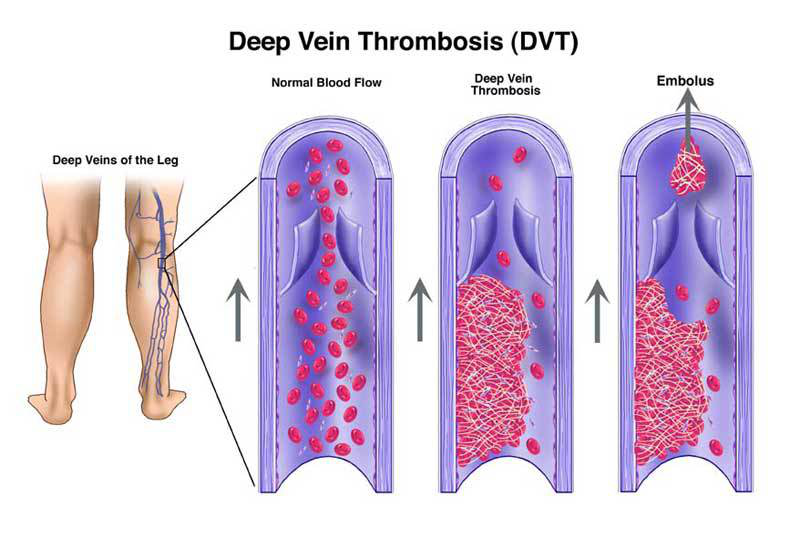Deep Vein Thrombosis in India
About Deep Vein Thrombosis
The formation of a thrombus, or a blood clot, is caused by deep vein thrombosis (DVT) in the deep leg vein. This is a very serious condition that may cause damage to the leg that is permanent. This is also known as post thrombotic syndrome. It may also cause a life-threatening pulmonary embolism, or blood clot in the lungs. 600,000 new cases are diagnosed each year. Of every 100 people who have DVT, one those will die. This has recently been called the “Economy Class Syndrome” because of it developing after sitting on long flights.
The veins are surrounded by powerful muscles that contract and force oxygen-less blood back to the lungs and the heart. These deep veins are near the center of the leg.
Because blood is squeezed up the leg against gravity and the valves prevent it from flowing back to our feet, one-way valves prevent the back-flow of blood between the contractions.
Blood can pool when the circulation of the blood slows down due to illness, injury or inactivity, providing an ideal setting for clot formation.
Post-thrombotic Syndrome
A common after-effect of having Deep Vein Thrombosis (DVT) if treated with anticoagulation drugs, or blood thinners, is post-thrombotic syndrome, which is under-recognized, because the clot remains in the leg. Anticoagulants don not actively dissolve the blood clot, contrary to popular belief. They just prevent new clots from forming. Even though the body will eventually dissolve a clot, the vein often becomes damaged in the meantime. A large number of these patients develop damage that is irreversible in the leg veins and the valves, thus resulting in the abnormal pooling of blood in the leg, fatigue, swelling, chronic leg pain, and in extreme cases, horrible skin ulcers. This is usually considered a long-term outcome but it actually occurs in as many as 60-70 percent of people and develops within two months developing Deep Vein Thrombosis (DVT). Through increasing information that blood clot removal via a procedure called interventional catheter-directed thrombolysis in selected cases of Deep Vein Thrombosis can stop the debilitating sequel of post-thrombotic syndrome and can improve the quality of life for the patient(s).
PULMONARY EMBOLISM
If left untreated, DVT, or deep vein thrombosis, can break off and get into the circulation, getting stuck in the lung, where stops the oxygen supply, and causes heart failure, which is known as a pulmonary embolism. Pulmonary embolisms can be fatal. If caught early, patients with Deep Vein Thrombosis (DVT) can reduce their probability of developing a life-ending pulmonary embolism to less than one percent. Heparin and Coumadin, both blood thinners, are effective in stopping further clotting and can stop a pulmonary embolism from developing.
If pulmonary embolism can be diagnosed and appropriate therapy started, the mortality can be reduced from approximately 30 percent to less than ten percent.
It is estimated that each year more than 600,000 patients suffer a pulmonary embolism.
One in every 100 patients who develop DVT die due to pulmonary embolism.
PE causes or contributes to up to 200,000 deaths annually in the United States.
A majority of pulmonary embolism are caused by DVT.
The manifestations are oftentimes nonspecific and can mirror numerous other cardiopulmonary occasions.
Catheter Directed Thrombolysis
Catheter-directed thrombolysis is done by interventional radiologist through guided imagining. Performed in a hospital’s interventional radiology suite, the procedure is designed to quickly dissolve the clot, restore the flow of blood in the vein and hopefully maintain valve function to lessen the risk of post-thrombotic syndrome.
The interventional radiologist embeds a catheter into the popliteal (a spot behind the knee) or other leg vein and strings it into the vein containing the clot utilizing imaging direction. The catheter tip is put into the clot and a “clot busting” medication is infused specifically to the thrombus (clot).The newer the clot, the quicker it breaks down – one to two days. Any narrowing in the vein that may prompt future clot arrangement could be recognized by venography, an imaging study of the veins, and treated by the interventional radiologist with an inflatable angioplasty or placement of a stent.
An interventional radiologist can insert a vena cava filter (a small device that functions like a catcher’s mitt to stop blood clots but allow normal non-clotting blood to pass) in patients whom this is not appropriate for and blood thinning medications are not an appropriate measure.
Deep Vein Thrombosis

Risk Factors
Above the age of 40
Limb trauma and/or orthopedic procedures
Obesity
Previous or current cancer
Previous DVT or family history of DVT
Immobility, such as bed rest or sitting for long periods of time
Hormone therapy or oral contraceptives
Pregnancy or post-partum
Coagulation abnormalities
Symptoms
Calf or leg pain or tenderness
Warm skin
Leg fatigue
Discoloration of the legs
Swelling of the leg or lower limb
Surface veins become more visible
Deep Vein Thrombosis Treatments :
Using blood thinners as an early treatment is important to stop a life-threatening pulmonary embolism, however, itdoes not treat the clot that already exists.
Blood Thinning Medication :
By treating early, blood thinners are given to keep the coagulation from developing or severing and traveling to the lung and bringing about a life-threatening pulmonary embolism by hindering the oxygen supply creating failure of the heart. In opposition to mainstream thinking, blood thinners (anticoagulants) don’t actively break down the coagulation, but rather keeps new clots from developing. Over time, the body will disintegrate the coagulation, but more often than not, the vein is damaged. To stop harm from occurring in the leg, patients receive catheter-regulated thrombolysis treatment.
If leg pain continues past seven days, seek a second opinion from an interventional radiologist.
For patients with Deep Vein Thrombosis (DVT), it is extremely important for them to be seen by an interventional radiologist for them to decide if catheter-directed thrombolysis may be of help to them. If treatment is performed with 10 days of symptoms starting, the treatment is highly effective.